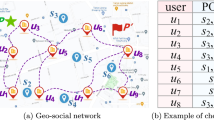Abstract
Since existing interest-clustering based P2P topological construction algorithms are usually based on the interests extracted from nodes’ shared files, they suffer from two problems that they are unable to make effective use of the free riders who account for the major part in P2P networks and they cannot effectively tackle the nodes’ interest-drifting problem. To address the problems, this paper makes a node connect to two interest clusters, one cluster is mainly used to serve the node (we call it the node’s needed-cluster), and another cluster is served by the node (we call it the node’s provided-cluster). First, we initially have a node join its expected interest cluster (i.e. the needed-cluster) by using its virtual interest so as to solve the problem of how to make a free rider or a node whose current interest is different from that extracted from its shared files join the network. Also, we have a node who provides shared files join another interest cluster (i.e. the provided-cluster) based on the interest extracted from its shared files so as to make the node better serve the nodes in its provided-cluster. Second, we propose a retrieval algorithm based on the nodes’ needed-clusters and provided-clusters. We also discuss how to adjust a node’s interest clusters and how to encourage the free riders to share their files. The simulation results show that our strategy could largely improve the retrieval efficiency and effectively encourage the free riders to share their resources.










Similar content being viewed by others
References
Eng Keong Lua, Jon Croweroft, Marcelo Pias, Ravi Sharma, Steven Lim. A survey and comparison of peer-to-peer overlay network schemes. IEEE Communications Survey and Tutorial, 2005,7 (2):72–93.
Eytan Adar, Bernardo A. Free Riding on Gnutella. First Monday.2000, 5 (10):134–139
Ripeanu M (2001) Peer-to-peer architecture case study: Gnutella network. Proceedings of the First International Conference on Peer-to-Peer Computing. IEEE, Linkoping, pp 99–100
Hsiao H-C, Su H-W (2012) On optimizing overlay topologies for search in unstructured peer-to-peer networks. IEEE Transactions on Parallel and Distributed Systems 23(5):924–935
Li M, Lee W-C (2008) Sivasubramaniam. SSW: a small-world-based overlay for peer-to-peer search. IEEE Transactions on Parallel and Distributed Systems 19(6):735–749
Kate Ching-Ju Lin, Chun-Po Wang, Cheng-Fu Chou, Leana Golubchik. SocioNet: A Social-Based Multimedia Access System for Unstructured P2P Networks. IEEE Transactions on parallel and distributed systems, 2010, 21 (7): 1027–1041.
Zhu Y, Hu Y (2006) Enhancing search performance on Gnutella-like P2P systems. IEEE Transactions on Parallel and Distributed Systems 17(12):1482–1495
Tseng Y-M, Chen F-G (2011) A free-rider aware reputation system for peer-to-peer file-sharing networks. Expert Syst Appl 38(3):2432–2440
Yijiao Y, Hai J (2008) A survey on overcoming free riding in peer-to-peer networks. Chinese journal of computers 31(1):1–15
Erdős P, Rényi A (1960) On the evolution of random graphs. Publ Math Inst Hungar Acad Sci 5(6):17–61
Guofu F, Jincheng Z, Yuquan J (2007) Optimization of overlay topology for unstructured peer-to-peer. Journal of software 18(11):2819–2829
Liang Jian, Rakesh Kumar, Keith Ross. Understanding KaZaA. Submetido para publicaçao, 2004
Faloutsos M, Faloutsos P, Faloutsos C (1999) On power-law relationships of the internet topology. ACM SIGCOMM Computer Communication Review ACM 29(4):251–262
Clarke I, Sandberg O, Wiley B, Freenet (2001) A distributed anonymous information storage and retrieval system. Designing Privacy Enhancing Technologies. Springer Berlin Heidelberg, New York, pp 46–66
Luis Rodero-Merino, Antonio Fernández Anta, Luis López, Vicent Cholvi. Self-managed topologies in P2P networks. Computer networks, 2009,53 (10): 1722–1736.]
Chawathe Y, Ratnasamy S, Lanham N, Shenker S (2003) Making Gnutella like P2P systems scalable. Proceedings of the 2003 Conference on Applications, Technologies, Architectures, and Protocols for Computer Communications. SIGCOMM, Karlsruhe, Germany, pp 407–418
Fortunato S (2010) Community detection in graphs. Phys Rep 486(3):75–174
Joung Y-J, Chiu TH-Y, Chen S-M (2012) Cooperating with free riders in unstructured P2P networks. Comput Netw 56(1):198–212
Chunxiao X, Fengrong G, Sinan Z (2007) A collaborative filtering recommendation algorithm incorporated with user interest change. Journal of Computer Research and Development 44(2):296–301
Renninger K. The role of interest in learning and development. Lawrence Erlbaum Associates, Inc., Publishers, 365 Broadway, Hillsdale, NJ 07642. 1992.
Shi W, Wen G, Jintao L, Tiejun H (2001) Mining interest navigation pattern based on hidden Markov model. Chinese journal of computers 24(2):152–157
Cunhe L, Xianfeng Y, Peiying Z (2007) The multi-level algorithm of mining users’ interests based on web mining and relevance feedback. Microcomput Appl 28(9):911–915
Zhang Y, Yudong L, Zhao J (2009) Vector similarity measurement method. Tech Acoust 28(4):532–536
Hughes D, Coulson G, Walkerdine J. Free riding on Gnutella revisited: the bell tolls?. Distributed Systems Online, IEEE, 2005, 6 (6)
PeerSim [EB/OL]. http://peersim.sourceforge.net/.
Montresor A, Jelasity M. PeerSim: A scalable P2P simulator. IEEE Ninth International Conference on Peer-to-Peer Computing. IEEE, 2009: 99–100.
Author information
Authors and Affiliations
Corresponding author
Rights and permissions
About this article
Cite this article
Meng, X., Jin, J. A free rider aware topological construction strategy for search in unstructured P2P networks. Peer-to-Peer Netw. Appl. 9, 127–141 (2016). https://doi.org/10.1007/s12083-014-0318-7
Received:
Accepted:
Published:
Issue Date:
DOI: https://doi.org/10.1007/s12083-014-0318-7




